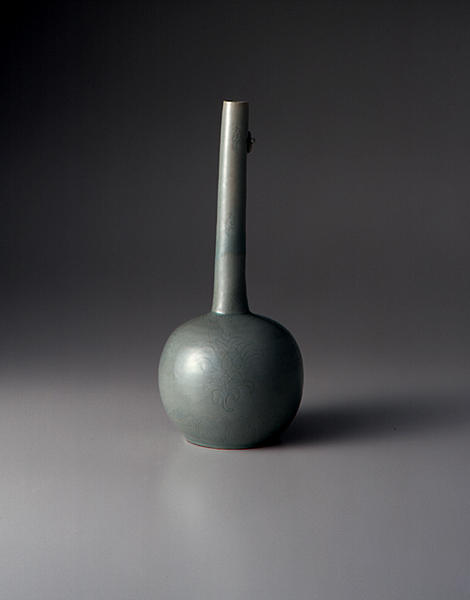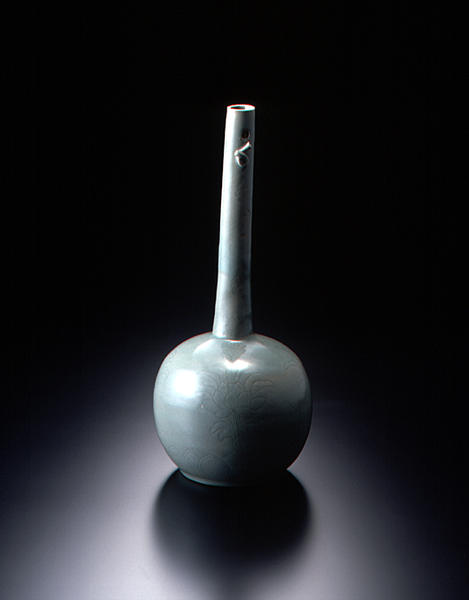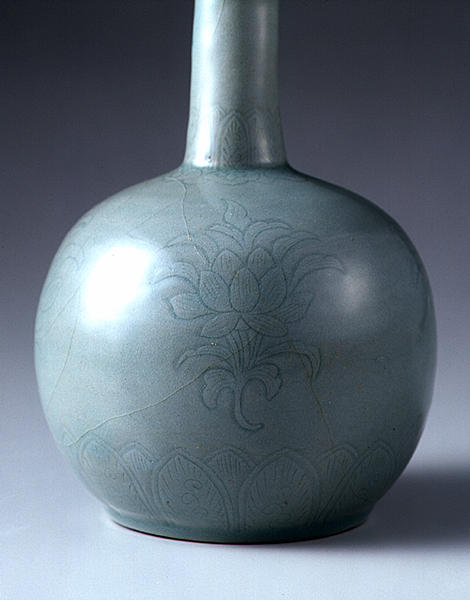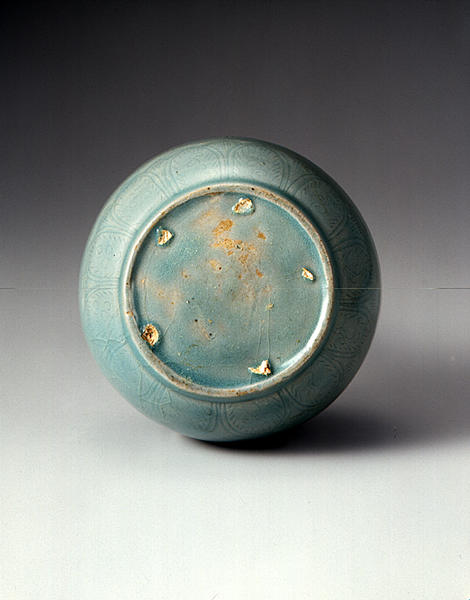青磁陽刻蓮花文鶴首瓶
- 高麗時代
- 12c
- 陽刻青磁
- H-34 D-15
高麗青磁は、十一世紀末ごろには釉の透明度が高くなり胎土が一層精選されて本格的に翡色(ひしょく)を帯びはじめる。いわゆる「翡色青磁」である。十二世紀には、陰刻・陽刻・印花・透彫・象嵌などの装飾技法が開発され、当時の王侯貴族の嗜好に合った華麗な青磁を生み出した。
宣和(せんな)五年(高麗仁宗一年、1123年)、高麗の都・開城を訪れた中国使節団に随行した徐兢(じょきょう)が、高麗国の様子を四〇巻の旅行見聞録にまとめ徽宗皇帝に献上した。これを「宣和奉使高麗図経(略して高麗図経)」という。そこには、「器皿多以塗金或銀、而以青陶為貴」「陶器色之青者、麗人謂之翡色」とあり、当時の高麗の人々は金や銀を塗った器皿より青磁を貴び、翡色(ひそく)と呼んでいたこと、また「精絶」と言われるほどの精緻な彫り文様の施されたものが生産されていたことなどが記されている。「翡色」という呼称は高麗青磁の釉色が翡翠の緑やカワセミの翼の緑色に似ているところから、また、中国の越州青磁の青を秘色と呼んだことからきていると想像される。
この鶴首瓶は胴部の四面に蓮花文が大きく配されている。胴裾には蓮弁文、頚裾には如意頭文の帯を巡らし、頚部には雲文を散らす。底部には5ヶ所の目跡が残る。細く伸びた頚に豊満な胴をもつその姿と、底部まで施された青磁釉の翡色の美しさは本作品の真骨頂であり、まさに隠れた名品といえる。
解説(開館1周年記念展)
高麗青磁は,11世紀末頃には釉の透明度が高くなり胎土が一層精選されて本格的に翡色を帯び始める。いわゆる「翡色青磁」である。12世紀には,陰刻・陽刻・印花・透彫・象嵌などの装飾技法が開発され,当時の王侯貴族の嗜好に合った華麗な青磁を生み出した。
宣和5年(高麗仁宗元年,1123年),高麗の都・開城を訪れた中国使節団に随行した徐兢が,高麗国の様子を40巻の旅行見聞録にまとめ徽宗皇帝に献上した。これを「宣和奉使高麗図経(略して高麗図経)」という。そこには,「器皿多以塗金或銀,而以青陶為貴」「陶器色之青者,麗人謂之翡色」とあり,当時の高麗の人々は金や銀を塗った器皿より青磁を貴び,翡色と呼んでいたこと,また「精絶」と言われるほどの精緻な彫り文様の施されたものが生産されていたことなどが記されている。「翡色」という呼称は高麗青磁の釉色が翡翠の緑やカワセミの翼の緑色に似ているところから,また,中国の越州青磁の青を秘色と呼んだことからきていると想像される。
この鶴首瓶は胴部の4面に蓮花文が大きく配されている。胴裾には蓮弁文,頚裾には如意頭文の帯を巡らし,頚部には雲文を散らす。底部には5か所の目跡が残る。細く伸びた頚に豊満な胴をもつその姿と,底部まで施された青磁釉の翡色の美しさは本作品の真骨頂であり,まさに隠れた名品といえる。
Catalogue Entry
As the glaze became highly transparent and the clay more carefully chosen, Koryo celadon began to impart a true jade-like color by the end of the 11th century. This type of celadon is called "jade-colored celadon." In the 12th century, various decorative techniques were developed, such as incised design, carved design, impressed design, openworked design, inlaid design, and so on, and artists created splendid celadon ware favored by kings and nobles of that time.
A man by the name of Xu Jing visited the capital of the Koryo dynasty Kaesong while accompanying a Chinese delegation in 1123, and compiled a forty volume record detailing his experience in the city, which he presented to Emperor Hui-zong of the Northern Song as a tribute. These records are called "Gaoli-tujing" (The Illustrated Report on Gaoli, Gaoli being Chinese name of Koryo). According to this work, the people of the Koryo dynasty apparently valued celadon more than vessels covered in gold or silver, and the people referred to celadon by a special term hishoku (jade/kingfisher colored). Also recorded is a kind of exquisite celadon described as being extremely intricate, with highly-detailed, elaborately incised patterns. The name hishoku is presumed to have originated because the Koryo celadon's green color is similar to the color of green jade, or perhaps because the color resembles the green color of the wings of the kingfisher. Another possibility is that the term may have originated from a type of blue glaze also called hishoku but written in different characters used on celadon ware from a specific part of China.
This tall-neck vase is designed with large lotus flowers all around the body. Lotus petals surround the bottom, and nuyi pattern (lapet or cloud collar pattern) adorns the part that serves as the transition from the neck to the rest of the vessel. Cloud motifs appear around the neck. Five spurs are found on the bottom. The round, plump shape of the vessel with a long thin neck, graced with the beautiful jade color applied on all surfaces, represents its most treasured feature. It truly qualifies as a masterpiece, the value of which is yet to be fully appreciated.



